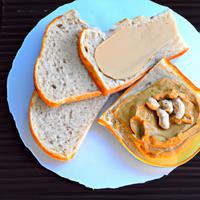
1 serving (30 grams) contains 80 calories, 2.7 grams of protein, 1.0 grams of fat, and 14.7 grams of carbohydrates.

Log this food in SnapCalorie

Nutrition Information
Calories |
626.0 | ||
|---|---|---|---|
% Daily Value* |
|||
| Total Fat | 7.6 g | 9% | |
| Saturated Fat | 1.7 g | 8% | |
| Polyunsaturated Fat | 0 g | ||
| Cholesterol | 0 mg | 0% | |
| Sodium | 1159.8 mg | 50% | |
| Total Carbohydrates | 115.7 g | 42% | |
| Dietary Fiber | 6.4 g | 22% | |
| Sugars | 11.8 g | ||
| protein | 21.3 g | 42% | |
| Vitamin D | 0 mcg | 0% | |
| Calcium | 340.2 mg | 26% | |
| Iron | 11.6 mg | 64% | |
| Potassium | 271.7 mg | 5% | |
* Percent Daily Values are based on a 2,000 calorie diet. Your daily values may be higher or lower depending on your calorie needs.
Food Attributes
Source of Calories
About Bread and peanut paste
Bread and Peanut Paste is a simple yet nutrient-rich combination often enjoyed as a quick snack or meal. Originating as a staple in various cuisines, peanut paste—commonly made from ground roasted peanuts—provides a creamy texture with a savory and slightly sweet flavor. This spread is high in protein, healthy fats, and essential nutrients like magnesium, vitamin E, and niacin, making it a great energy source. It pairs well with bread, which supplies carbohydrates for a balanced meal. Whole-grain bread is the healthiest option, offering fiber and additional vitamins compared to refined versions. However, moderation is key, as peanut paste can be calorie-dense, especially if sweetened or salted varieties are used. While it’s a satisfying and quick choice for breakfast or a snack, those sensitive to peanuts or managing calorie intake should consider portion sizes and ingredient quality.



